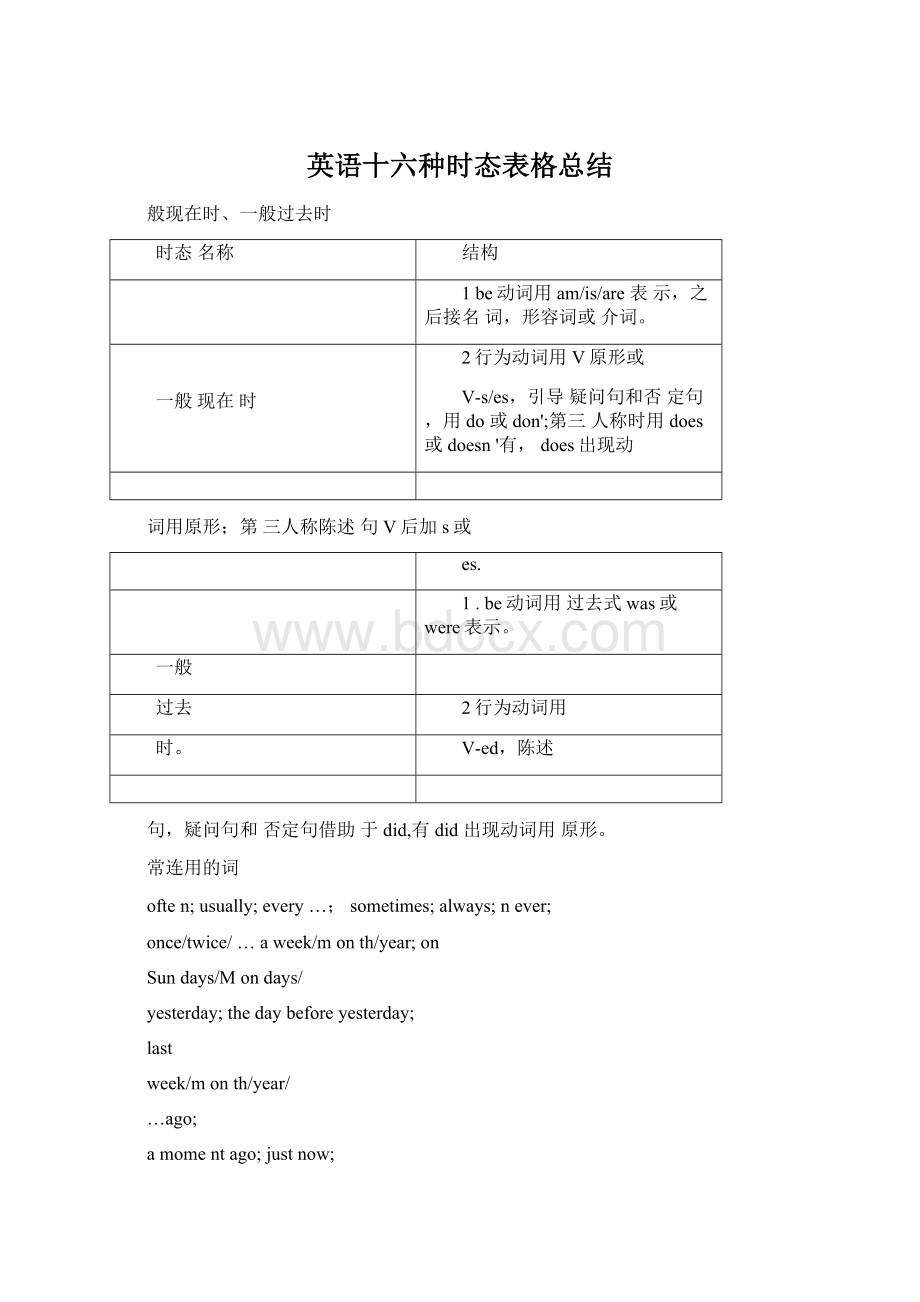英语十六种时态表格总结.docx
《英语十六种时态表格总结.docx》由会员分享,可在线阅读,更多相关《英语十六种时态表格总结.docx(19页珍藏版)》请在冰豆网上搜索。

英语十六种时态表格总结
般现在时、一般过去时
时态名称
结构
1be动词用am/is/are表示,之后接名词,形容词或介词。
一般现在时
2行为动词用V原形或
V-s/es,引导疑问句和否定句,用do或don';第三人称时用does或doesn'有,does出现动
词用原形;第三人称陈述句V后加s或
es.
1.be动词用过去式was或were表示。
一般
过去
2行为动词用
时。
V-ed,陈述
句,疑问句和否定句借助于did,有did出现动词用原形。
常连用的词
often;usually;every…;sometimes;always;never;
once/twice/…aweek/month/year;on
Sundays/Mondays/
yesterday;thedaybeforeyesterday;
last
week/month/year/
…ago;
amomentago;justnow;
on/in+过去的时间
主要用法
一般现在时表示没有时限的持久存在的习惯性的动作或状态,或现阶段反复发生的动作或状态,或一般真理
在过去时间里所发生的动作或存在的状态。
例句
陈述句:
Iamanofficeworker.
Heissolazy.Theyareathomenow.否定句:
IamnotTim.
Sheisnotverybeautiful.
Theyarenotintheoffice.一般疑问句:
Areyouanofficeassistant?
Isshebeautiful?
陈述句:
IworkinShanghai.
Heworksathome.
DavyneverwatchesTVathome.否定句:
Idon'tlikethefoodinKFC.
Davydoesn'tlikethefoodinKFCeither.一般疑问句:
Doyouwantacupofcoffee?
Doesshelivenearthesubwaystation?
陈述句:
Iwasabigboss.Hewasbeautiful.WewereinBeijinglastyear.
否定句:
Iwasnotathomeatthatmoment.Wewerenotatworkyesterday.
一般疑问句:
Wereyouateacher?
Wassheintheofficelastweek?
陈述句:
IworkedinSunmoon.
WestudiedEnglishthere.HelivedinHongKong.
否定句:
Ididn'tworkhere.
Theydidn'tseeme.ShelikedEnglishal一般疑问句:
DidyougotoAmerica?
DidheworkinSunmoon?
般将来时、过去将来时
时态名称
结构
常连用的词
主要用法
例句
一般将来时
1任何人称+will+V原形•
tomorrow,thedayaftertomorrow;soon;nextweek/month/year/...;
即将发生动作或状^态。
陈述句:
IwillflytoHongKongtomorrow.
Hewillgowithus.
WewillarriveinShanghainextweek.否定句:
Iwillneverbelieveyouagain.
Hewillnotcometonight.
Wewillnotbuyacarnextyear.一般疑冋句:
Willyougotherebytrain?
Willhecometomorrow?
Willtheyliveafive-starhotel?
2is/am/are+goingto+V原形,表示计划打算做什么事情。
the
week/month/year/...afternext;
on/in+将来的时间;in+一段时间;.
陈述句:
1'mgoingtogotoHongKongbyair.
否定句:
Wearenotgoingtobuyahousehere.
一般疑冋句:
Aretheygoingtochangetheirjobs?
特殊疑问句:
Howareyougoingtotellhim?
过去将来时
was/weregoingto+V原形
多用在宾语从句中
在过去将会发生的动作。
陈述句:
Iwasgoingtobuyacomputer.Theytoldmethattheywerenotgoingtogoabroad.(间接引语)否定句:
Iwasnotgoingtobuyacomputer.
任何人称+would+V原形
HesaidhewouldcomeinShanghai.IsaidIwouldbuyyouacaroneday.
现在进行时、过去进行时
时态名称
结构
常连用的词
主要用法
例句
现在进行时
is/am/are+V-ing
now;
atpresent;atthemoment;
Look!
(放在句首);
Listen!
(放在句首);
表示现在(指说话人说话时)正在发生的事情。
陈述句:
I'mwaitingformyboyfriend.Heisdoingthehouseworkathomenow.Weareenjoyingourselves.
否定句:
Heisnotplayingtoys.一般疑冋句:
Areyouhavingdinnerathome?
IsTimcookinginthekitchen?
特殊疑问句:
Whatareyoudoingnow?
Wherearetheyhavingameal?
过去进行时
was/were+V-ing
atthattime;atthistimeyesterday;at+时间点+yesterday/lastnight;
atthatmoment;
过去一段时间正在发生的事情。
陈述句:
1wasdoingmyhomeworkatthattime.
Wewerehavingapartywhilehewassleeping.
否定句:
Hewasnotsleepingat11o'clock
night.
一般疑问句:
WereyouwatchingTVatthattime?
特殊疑问句:
Whatwereyoudoingatthatmoment?
现在完成时、过去完成时
时态名称
结构
常连用的词
主要用法
例句
现在完成时
have/has+
p.p(过去分词)
already;just;before;yet(否定句中);ever;never;
once/twice/…fo叶一段时间;since+时间点;since+一段时间+ago;by+现在时间;
sofar;uptonow;tillnow;untilnow;
recently/lately;during/over/inthepast/last
用来表示之前已发生或完成的动作或状态,其结果的确和现在有联系。
动作或状态发生在过去但它的影响现在还存在;也可表示持续到现在的动作或状态。
陈述句:
1havealreadytoldDavy.Davyhasknownthismatter.
Hehaslivedherefornearly10years.否定句:
Ihaven'tfinishedmyhomework..
Timhasn'tcomeyet.
Wehaven'tehrdanynewsabouthim一般疑冋句:
Hasheworkedheresincehecamehere?
特殊疑问句:
Howlonghaveyouworkedinthiscompany?
特别注意:
1.have/hasalwaysbeen+名词/形谷词/介词:
总是或一直是什么样子。
。
。
Hehasalwaysbeenagoodfather.
Ihavealwaysbeenbusy.
TheyhavealwaysbeeninAmerica.
2.have/hasgoneto:
去了某地(未归)HehasgonetoBeijing.
Theyhavegonetothecinema.
3.have/hasbeento:
表示去过或到过某地
IhavebeentoCanada.HaveyoubeentoHongKong?
Wherehaveyoubeen?
1haveneverbeenhere.
过去完成时
had+过去分
词
过去的过去:
by+过去的时间
(在XX之前,不迟于);表过去某动作或时间以前”的时间状语。
动作发生在过去的过去。
陈述句:
HesaidhehadtoldDavy.(间接引语)HelefttheofficeafterhehadcalledDavy.
Bytheendofthedaywehadsoldover2000tickets.
否定句:
Shehadn'thaddinnerbeforeshewentout.
一般疑冋句:
HadshelearntEnglishbeforeshemovedhere?
特殊疑问句:
howmanyEnglishwordshadhelearntbytheendoflastyear?
英语时态举例
SimplePresent
SimplePast
SimpleFuture
一般现在时
一般过去时
一般将来时
句子结构:
主语+will+V.
Ifyouarehavingproblems,
句子结构:
主语+V
句子结构:
主语+V-ed
IwillhelpyoustudyEnglish.
如果你在学习英语当中,遇到问题,我
IstudyEnglisheveryday.
Twoyearsago,
将帮助你.
IstudiedEnglishinAmerica.
我每天都学习英语•
两年前,我在美国学英语•
句子结构:
主语+begoingto+V
I'goingtostudyEnglishnext
year.
我明年将开始学习英语.
PresentContinuous
PastContinuous
FutureContinuous
现在进行时
过去进行时
将来进行时
句子结构:
主语+willbe+doing
IwillbestudyingEnglishwhen
句子结构:
主语
youarrivetonight.
+was/were+doing
句子结构:
主语+be+doing
IwasstudyingEnglishwhen
明晚你来的时候,我会正在学习英语.
IamstudyingEnglishnow.
句子结构:
主语+begoingto+be+doing
youcalledyeaterday.
我正在学习英语•
你昨天给我打电话的时候,我正在
I'goingtobe
学习英语•
studyingEnglishwhenyou
arrivetonight.
同上.
PresentPerfect
现在完成时
PastPerfect
过去完成时
FuturePerfect
将来完成时
句子结构:
主语+have/has
句子结构:
主语+haddone
句子结构:
主语+will+havedone
Iwillhavestudiedeverytense
bythetimeIfinishthiscourse.
在我完成这个课程的时候,我已经能
done
完成英语时态的学习了.
IhavestudiedEnglishin
IhadstudiedalittleEnglishbeforeImovedtotheU.S.
句子结构:
主语+begoing
severaldifferentcountries.
在一些国家,我已经学习了英语.
在我搬去美国之前,我已经学习了
to+havedone
一点央语.
I'goingtohavestudiedevery
PresentPerfectContinuous
PastPerfectContinuous
tensebythetimeIfinishthiscourse.
同上.
FuturePerfectContinuous
现在完成进行时
过去完成进行时
将来完成进行时
句子结构:
主语+have/has
句子结构:
主语+hadbeendoing
句子结构:
主语+willhavebeendoing
IwillhavebeenstudyingEnglishforoverthree
beendoing
IhadbeenstudyingEnglish
hoursbythetimeyouarrive.
IhavebeenstudyingEnglish
fortenyearsbeforeImovedtotheU.S.
明晚你来的时候,我已经学习英语3
fortenyears.
个小时了.
我已经学习英语有十年的时间了.
在我搬去美国之前,我已经学习了十年的英语了.
句子结构:
主语+begoingtohave
beendoing
ImgoingtohavebeenstudyingEnglishforoverthree
hoursbythetimeyouarrive
同上.
详细讲解-一般现在时
通常以动词原形表示。
主语为第三人称单数时,用现单三形式。
动词be和have(表示拥有”各人称的单数形式为:
第一人称单数第二人称单数第三人称单数
HaveHaveHaveHas
BeAmAreis
一般现在时的否定式、疑问式和简单回答形式如下:
动词be与have(表示拥有”):
否定式直接把not放在动词之后,疑问式直接把动词放在主语之前,见下表:
否定式&疑问式
BeHaveBeHave
Iamnot(I'mnot)…Ihavenot(haven't)…Ami…?
Havei…?
Youarenot(aren't)…Youhavenot(haven't)…Areyou…?
Have
you…?
Heisnot(isn't)…Hehasnot(hasn't)…Ishe…?
Hashe…?
动词be的否定疑问式和简单回答:
动词be与have(表示拥有”:
)否定式直接把not放在动词之后,疑问式直接把动词放在主语
之前,见下表:
否定式疑问式
Be
Have
Be
Have
Iamnot(I'mnot)
…Ihavenot(haven
't)…Ami
…?
HaveI…?
Youarenot(aren't)
…Youhavenot
(haven't)…
Areyou…?
Have
you…?
Heisnot(isn't)…
-Hehasnot(hasn
't)…Ishe
-?
Hashe…?
动词have(表示拥有”)的否定疑问式和简单回答:
否定疑问式肯定回答否定回答
HaveInot(haven
'ti)…
Yes,youhave.
No,youhaven't.
Haveyounot(haven
'tyou)
…?
Yes,Ihave.
No,Ihaven't
Hashenot(hasn
'the)…
?
Yes,hehas.
No,hehasn't.
注意:
have作为行为动词则只能按照行为动词的规则变化。
行为动词(以study为例)一般现在时的否定式、疑问式和简单回答(注意要加助动词do/does)否定式疑问式
Idonot(don't)studyDoIstudy
Youdonot(don't)studyDoyoustudy
Hedoesnot(doesn't)studyDoeshestudy
否定疑问句式
简单回答(肯定/否定)
DoInot(Don
'tI)study…Yes,1do.No,Idon't.
Doyounot(Don
'tyou)study…Yes,youdo.No,youdon't.
Doeshenot(Doesn'the)study…Yfes,hedoes.No,hedoesn't.
详细讲解-现在进行时、一般过去时
由助动词be+现在分词构成。
其中be有人称和数的变化,有三种形式:
第一人称单数用am,第三人称单数用is,其他用are。
现在进行时的否定式是:
直接在助动词be后面加上not;疑问式是:
把助动词be提到主语之
前。
以study为例:
否定式疑问式
IamnotstudyingAmIstudying?
Youarenotstudying.Areyoustudying?
Heisnotstudying.Ishestudying?
一般过去时
一般过去时通常由动词过去式表示。
一般过去时的否定式、疑问式和简单回答形式要用助动词do的过去式did,同时注意实义动词要用原形。
以study为例,其否定式、疑问式和简单回答形式如下:
否定式疑问式
Ididnot(didn't)studyDidI-study…?
Youdidnot(didn't)studyDidyoustudy…?
Hedidnot(didn't)studyDidhestudy…?
否定疑问式简单回答(肯定/否定)
DidInot(Didn'tI)study-es,youdid.No,youdidn't.
Diyounot(Didn'tyou)studyYes…?
id.No,Ididn't.
Didhenot(Didn'the)studyYes,hedid.No,hedidn't.
详细讲解-过去进行时、过去完成时
过去进行时
由助动词be的过去式+现在分词构成。
其中be有人称和数的变化,第一、第三人称单数用was,其他用were.
1)过去进行时动词主要表示在过去某一时刻或某一段时间内正在进行或持续进行的动作。
过去进行时经常与过去时配合使用。
例如:
Thistimeyesterday,wewerehavinganEnglishlesson.昨天这个时候,我们正在上英语课。
TheteacherwasgivingusalessonwhenTomwalkedintotheroom.老师在给我们上课时,
汤姆走进教室。
Whilewewerehavingsupper,allthelightswentout.我们吃饭的时候,灯灭了。
Hewasreadingwhileshewassettingthetable.她摆桌子时,他在读书。
Itwasgettingdark.Thewindwasrising.天渐渐黑下来了。
风势增强了。
2)过去进行时动词常用always,continually,frequently等词连用,表示过去经常发生的行为。
这种用法表明带有的感情色彩。
例如:
Thetwobrotherswerefrequentlyquarrelingwhentheywereyoung.两兄弟小时候常吵架。
InQingDynasty,Chinawasalwaysmakingconcessionstowesternpowers.清朝时,中国总是对西方列强妥协。
过去完成时
一律用had+过去分词构成。
用法:
1)表示发生在过去某一时间或动作之前的事情,即过去的过去”用过去完成时,必须有一个
过去的时间或动作来作参照,说明在此之前某事已发生。
如果两个动作都是在过去发生的,先发生的用过去完成时,后发生的用一般过去时。
例如:
Shetoldmeshehadbeentherethreetimesbefore.她告诉我她以前到过那里三次。
(去过”
发生在告诉”之前)
Howlonghadhetaughtherebytheendoflastterm?
到上学期末为止,他在这里教学多长时
间啦?
(教学”发生在上学期末结束之前)
Whenwear